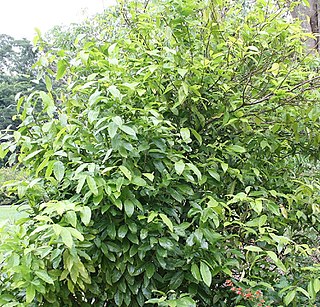Gonystylus is a southeast Asian genus of about 30 species of hardwood trees also known as ramin, melawis (Malay) and ramin telur (Sarawak).
Dipterocarpus stellatus is a tree in the family Dipterocarpaceae. The specific epithet stellatus means "star-like", referring to its trichomes.
Gonystylus affinis is a tree in the family Thymelaeaceae.
Gonystylus areolatus grows as a small tree up to 10 metres (33 ft) tall. Bark is greyish brown. Habitat is mixed dipterocarp forest at around 50 metres (160 ft) altitude. G. areolatus is endemic to Borneo.
Gonystylus borneensis grows as a tree up to 35 metres (115 ft) tall, with a trunk diameter of up to 60 centimetres (24 in). Bark is greyish brown. Fruit is round, brown, up to 7 centimetres (2.8 in) in diameter. Habitat is forest from sea-level to 500 metres (1,600 ft) altitude. G. borneensis is endemic to Borneo.
Gonystylus brunnescens grows as a tree up to 40 metres (130 ft) tall, with a trunk diameter of up to 100 centimetres (40 in). Bark is reddish to dark brown. Fruit is round, brown, up to 7 centimetres (2.8 in) in diameter. The specific epithet brunnescens is from the Latin meaning "brownish". Its habitat is forest from 40 to 1,500 metres altitude. G. brunnescens is found in Peninsular Malaysia and Borneo.
Gonystylus calophyllus is a tree in the family Thymelaeaceae. The specific epithet calophyllus means "beautiful leaves".
Gonystylus eximius is a tree in the family Thymelaeaceae. The specific epithet eximius means "excellent".
Gonystylus forbesii is a tree in the family Thymelaeaceae.
Gonystylus maingayi is a tree in the family Thymelaeaceae.
Gonystylus micranthus grows as a tree up to 25 metres (82 ft) tall, with a trunk diameter of up to 60 centimetres (24 in). Bark is dark brown. The fruit is dark brown, up to 4 centimetres (1.6 in) long. Its habitat is forest from sea-level to 100 metres (330 ft) altitude. G. micranthus is endemic to Borneo.
Gonystylus othmanii is a tree in the family Thymelaeaceae.

Phaleria perrottetiana is a plant in the family Thymelaeaceae.
Helicia attenuata is a plant in the family Proteaceae. The specific epithet attenuata means "drawn out", referring to the leaf base.
Helicia petiolaris is a plant in the family Proteaceae. The specific epithet petiolaris means "stalked", referring to the leaves.
Madhuca hirtiflora is a plant in the family Sapotaceae. The specific epithet hirtiflora means "hairy flowers".
Madhuca motleyana is a tree in the family Sapotaceae. It is named for engineer and naturalist James Motley, who lived and worked in Borneo in the 1850s.
Chisocheton velutinus is a tree in the family Meliaceae. The specific epithet velutinus is from the Latin meaning "velvety", referring to the indumentum of the leaves and fruits.
Castanopsis javanica, the Javan chestnut-oak, is a tree in the beech family Fagaceae. The specific epithet javanica is from the Latin, meaning "of Java".
Lithocarpus gracilis is a tree in the beech family Fagaceae. The specific epithet gracilis is from the Latin meaning "slender", referring to the twigs.

